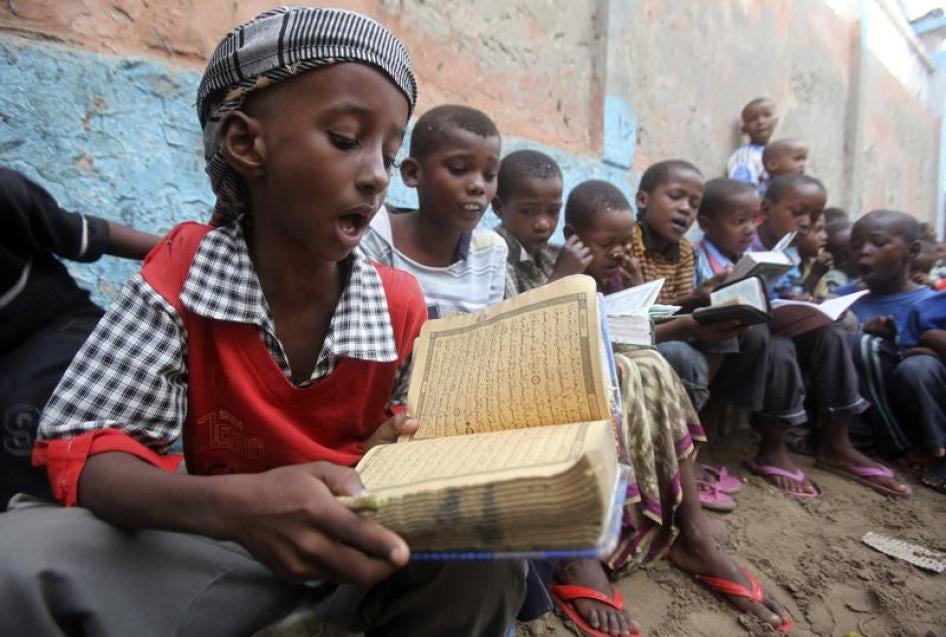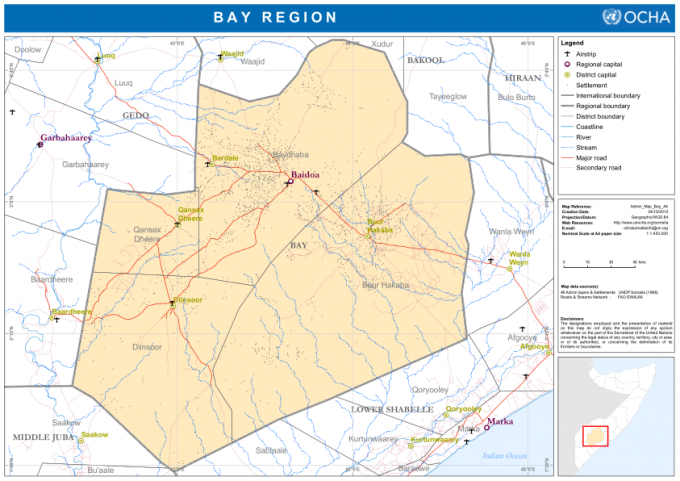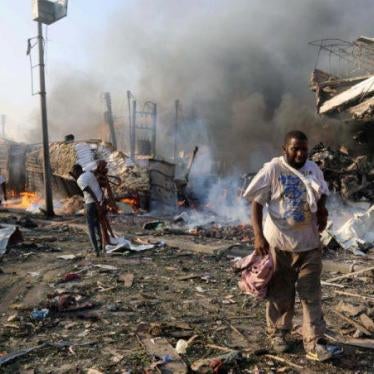(Nairobi) – The Islamist armed group Al-Shabab has threatened and abducted civilians in Somalia’s Bay region to force communities to hand over their children for indoctrination and military training in recent months.
Since late September 2017, Al-Shabab has ordered elders, teachers in Islamic religious schools, and communities in rural areas to provide hundreds of children as young as 8 or face attack. The armed group’s increasingly aggressive child recruitment campaign started in mid-2017 with reprisals against communities that refused. In recent months, hundreds of children, many unaccompanied, have fled their homes to escape forced recruitment.
“Al-Shabab’s ruthless recruitment campaign is taking rural children from their parents so they can serve this militant armed group,” said Laetitia Bader, senior Africa researcher at Human Rights Watch. “To escape that cruel fate, many children have fled school or their homes.”
Over the past decade, Al-Shabab has recruited thousands of children for indoctrination and to become frontline fighters. Since 2015, the armed group has opened several large Islamic religious schools in areas under their control, strengthened indoctrination methods including by bringing in younger children, and pressured teachers to retrain and teach Al-Shabab’s curriculum in schools.
On a recent trip to Baidoa, the capital of Bay region, Human Rights Watch spoke to 15 residents from three districts in Bay region largely under Al-Shabab control – Berdale, Baidoa, and Burhakaba districts – as well as child protection advocates and United Nations officials. The findings match similar trends in other parts of the country since mid-2017.
Village elders said that in September Al-Shabab ordered them to go to Al-Shabab-controlled Bulo Fulay and to hand over dozens of children ages 9 to 15. A resident of Berdale district said: “They said we needed to support their fight. They spoke to us in a very threatening manner. They also said they wanted the keys to our boreholes [watering points]. They kept us for three days. We said we needed to consult with our community. They gave us 10 days.” Two other community residents said that they received threatening calls, including death threats, after the 10 days ran out, but as of late 2017 they had not handed over the children.
Three residents said that in September Al-Shabab fighters forcibly took at least 50 boys and girls from two schools in Burhakaba district and transported them to Bulo Fulay, which witnesses say hosts a number of religious schools and a major training facility. Two weeks later, a large group of armed Al-Shabab fighters with their faces covered returned to the village, entered another local school, and threatened and beat the teacher to hand over children.
“They wanted 25 children ages 8 to 15,” said the teacher, who resisted the order. “They didn’t say why, but we know that it’s because they want to indoctrinate them and then recruit them. After they hit me, some of the children started crying and tried to run out of the classroom. But the fighters were all around. They caned a 7-year-old boy who tried to escape.”
The fighters gave the community 10 days to hand over the children.
Share this via Facebook Share this via Bluesky Share this via X Share this via WhatsApp Share this via Email More sharing options Share this via LinkedIn Share this via Reddit Share this via Telegram
Residents from Berdale district said that in at least four villages, Al-Shabab abducted elders who refused to hand over children. In one village, three elders were released only after they agreed to hand over eight boys from their village.
In May, Al-Shabab pressured elders and other residents in villages in central Somalia’s Mudug and Galgadud regions – from which Ethiopian military forces had recently withdrawn – to hand over children ages 7 to 15. A boy who fled Middle Shabelle region without his parents said: “Our school wasn’t controlled by Al-Shabab. Six weeks ago [late June], they came to our school, took down our names, and took two boys. The teacher managed to escape. They threatened that next time they would come back for us.”
A woman in Burhakaba district said that her four children had witnessed 25 of their classmates being abducted from their school: “The four of them are now so worried about going to school. But if they don’t go to school, and get the fundamentals of the religion, they will go to waste.” Some local religious schools in Bay region are closing fearing further attacks, or because the teachers have fled or been abducted.
Some residents said that their only option to protect their children was to send them, often unaccompanied, to areas outside of Al-Shabab control – a difficult and dangerous journey given the threat of Al-Shabab abduction along the way. Community elders and local monitors said the recruitment campaign has forced approximately 500 people as of October, often unaccompanied children, to flee their homes to Baidoa.
“I heard that children were being captured in neighboring villages and so got very scared,” said a 15-year-old who fled by foot with his 9-year-old brother to the nearest town. “My parents gave me money to come to Baidoa. My brother and I were very scared of being captured along the way, since we went through the bush.”
In August, an official from Adale in Middle Shabelle told the media that his community was hosting approximately 500 children ages 10 to 15 who had fled forced recruitment in Galgudud, Hiran and Middle Shabelle districts. Some children have fled to towns where they have relatives, others end up in dire conditions in internally displaced persons (IDP) camps. Local groups estimate that over half of the children recently displaced to Baidoa now live in IDP settlements. But unaccompanied children, especially those in informal camps, are unlikely to find security or schooling and may be forced to work to survive.
“The government with UN agency assistance should ensure that displaced children, including those without adult guardians, receive protection and appropriate schooling,” Bader said. “Children should not flee one danger zone for a new one.”
The UN Security Council’s Somalia Eritrea Monitoring Group (SEMG) reported that in June, Al-Shabab detained 45 elders in El Bur who refused to provide them with 150 children and only released them on the condition that the children would be handed over. The SEMG found that 300 children were abducted from the area during this period and taken to an Al-Shabab school.
In April Al-Shabab announced over its radio station that it was introducing a new curriculum for primary and secondary schools and warned teachers and schools against “foreign teachings.” A Bay region resident said that Al-Shabab took a dozen teachers for “retraining” around April, and they were only released after paying about US$300 per person. In certain areas, Al-Shabab ordered schools to shut down and communities to send their teachers to Al-Shabab curriculum training seminars, SEMG reported.
Human Rights Watch did not find clear evidence that children abducted in recent drives were taken directly for military training, but interviewees repeatedly raised the concern. The UN monitoring group reported that some of the schools set up by Al-Shabab were linked to military training facilities. Child abductions, notably from schools, and children’s use as fighters by Al-Shabab significantly increased in the second quarter of 2017, the UN monitoring group said. Boys who had been associated with Al-Shabab since late 2015 said that the religious schools and teachers were often used to recruit boys as fighters. These boys said their military training included a mixture of rudimentary weapons training and ideological indoctrination.
The Somali government has taken some steps to protect schools and students, Human Rights Watch said. In 2016 it endorsed the Safe Schools Declaration, an international commitment by countries to do more to ensure that schools are safe places for children, even during war. Somalia has signed but not yet ratified the UN Optional Protocol to the Convention on the Rights of the Child on children in armed conflict, which states that armed groups “should not, under any circumstances, recruit or use in hostilities persons under the age of 18 years.”
The government, with the help of international donors, should wherever possible identify Al-Shabab recruitment drives, including their location, scale, and use of educational institutions, that could inform protective measures, Human Rights Watch said. Doing so would also help efforts to assist displaced children, such as addressing their health, shelter, and security needs and providing them free primary education and access to secondary education, as well as appropriate psychosocial support.
“Al-Shabab’s campaign only adds to the horrors of Somalia’s long conflict, both for the children and their families,” said Bader. “The group should immediately stop abducting children and release all children in their ranks. The Somali government should ensure these children are not sent into harm’s way.”









